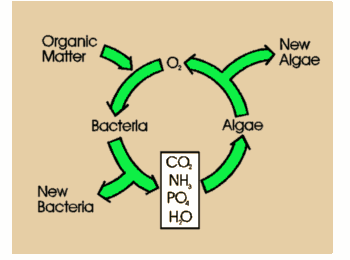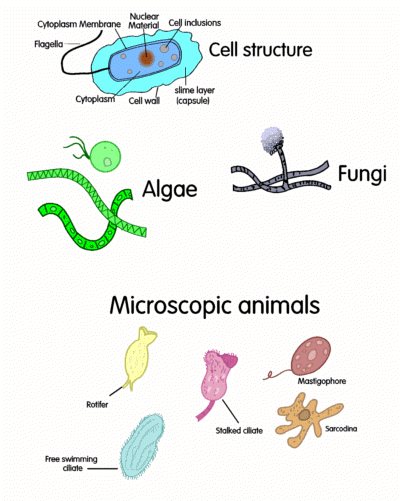
| Page 1 | Page 2 | Page 3 | Page 4 | Page 5 | Page 6 | HOME |
Microorganisms play a vital role in the normal biological cycle by converting soluble organic compounds into new bacterial cells and inorganic elements. This natural biological process provides conversion of waste organics (animal and plant life) to carbon dioxide and water.
Pathogenic bacteria cause disease to humans and animals, while non-pathogenic bacteria can be divided into chemosynthetics, (such as sulfur bacteria which oxidize hydrogen sulfide into free sulfur and sulfate), nitrifiers (which oxidize ammonia to nitrite, nitrate and nitrogen gas, depending on the level of aeration present), and saprophytics (organisms which live on dead organic materials).
While in nature, one finds a greater population of non-pathogenic bacteria than pathogenic bacteria, this balance may be upset in waste treatment facilities and high-density aquaculture ponds. By introducing large numbers of competitive non-pathogenic bacteria, such as those found in various Alken Clear-Flo® formulas, it is possible to crowd out many undesirable pathogenic strains while degrading various pollutants. True nitrifiers are chemolithotrophs , not heterotrophs, and will not properly tolerate the freeze-drying or spray-drying techniques to give them a shelf-lfie longer than 6 months at room temperaturee. If you see a powdered product claiming to contain true nitrifiers, you are being misled, either intentionally or because the manufacturer misunderstands the ammonia requirement of heterotrophs for growth and digestion of organic carbon. Six ppm of ammonia is required for every 100 ppm of organic carbon digested by heterotrophic microbes. In contrast, true nitrifiers can convert an unlimited amount of ammonia to nitrate, as long as BOD/COD is below 200 ppm, and works best if there is no longer any organic carbon present at all. There are a few rare strains of Bacillus, including Alken-Murray's Bacillus mojavensis AMH 118, which will oxidize ammonia to nitrite without the presence of an organic carbon, using our STP quality control test for nitrification. This is only half of the process, leaving the system with high levels of nitrite unless very specialized denitrifiers capable of converting nitrite to nitrogen gas are also present in the system to take the nitrite to nitrogen gas. The facultatively chemotrophic strains in Alken Enz-odor 6 and CF 1005 can complete this journey under aerobic conditions, but the quantity of ammonia converted will not be as great as when ammonia nitrifiers are used in the system. |

